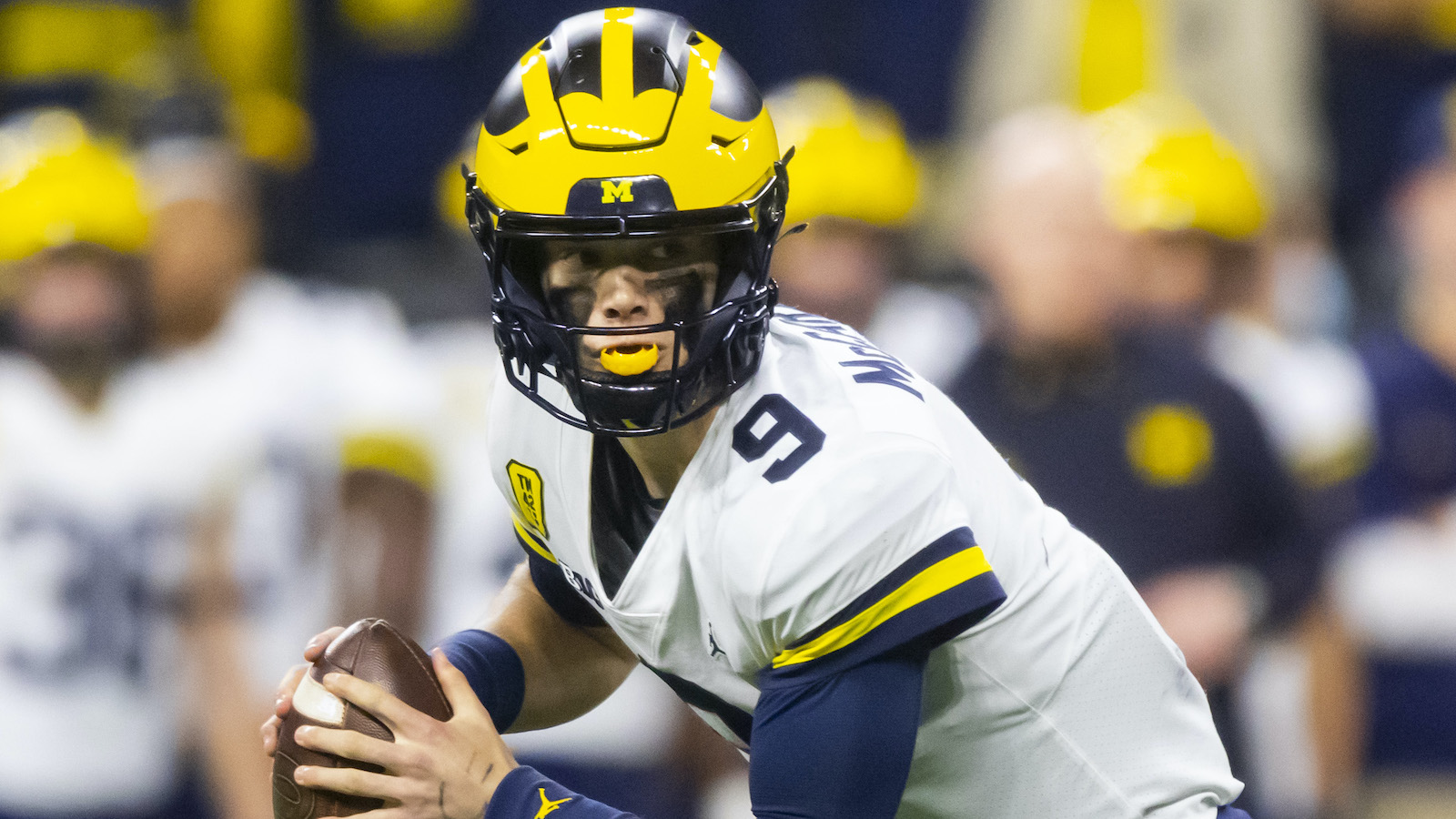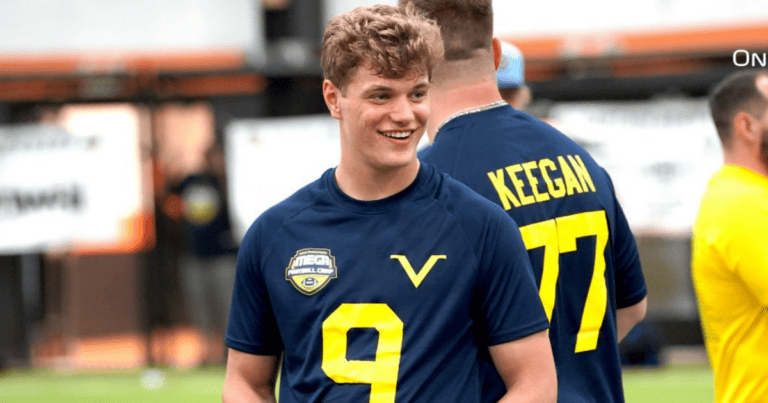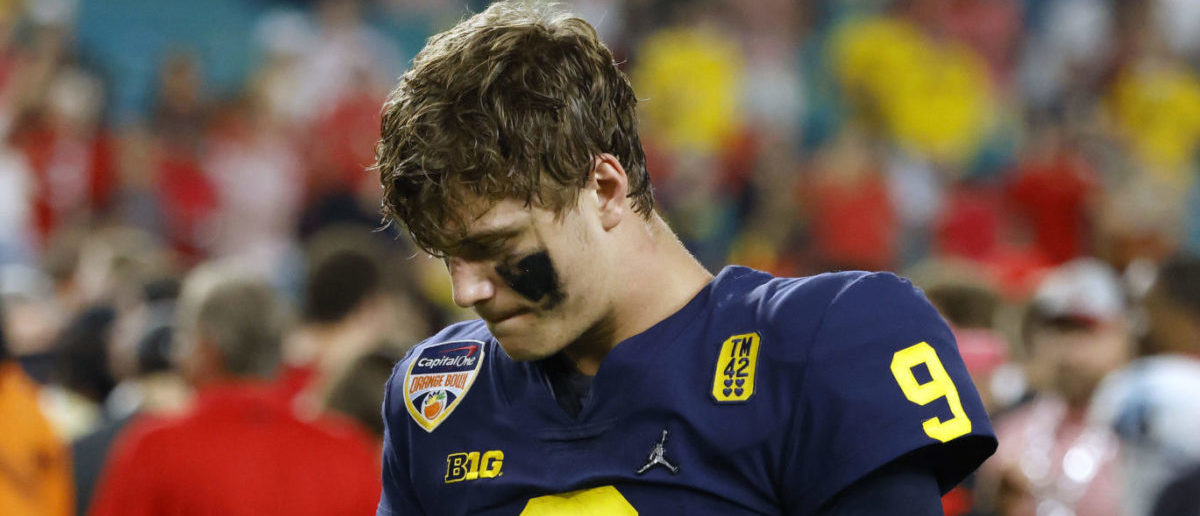JJ McCarthy’s Knee Injury and Recovery

JJ McCarthy, the talented quarterback for the University of Michigan Wolverines, suffered a significant knee injury during the 2023 season, impacting his performance and raising concerns about his future. This injury, a testament to the demanding nature of football, has tested his resilience and pushed him to navigate a challenging recovery process.
Nature of the Injury
JJ McCarthy’s knee injury involved a tear of the anterior cruciate ligament (ACL), a crucial ligament that provides stability to the knee joint. This injury is common in sports that involve sudden changes in direction and forceful movements, such as football. The ACL tear occurred during a game against the Penn State Nittany Lions on October 21, 2023, resulting in immediate pain and swelling.
Timeline of the Injury
- October 21, 2023: JJ McCarthy suffered an ACL tear during the game against Penn State. He was immediately removed from the game and underwent an MRI to confirm the diagnosis.
- October 23, 2023: The MRI results confirmed the ACL tear, and JJ McCarthy underwent surgery to repair the ligament.
- October 24, 2023: JJ McCarthy’s surgery was successful, and he began the rehabilitation process.
Surgical Procedure, Jj mccarthy knee surgery
The surgical procedure involved a reconstruction of the torn ACL using a graft, typically taken from another part of the body, such as the hamstring or patellar tendon. The graft is secured to the bone ends of the femur and tibia, creating a new ligament that provides stability to the knee joint. The specific technique used for the reconstruction can vary depending on the surgeon’s preference and the patient’s individual needs.
Rehabilitation Process
The rehabilitation process after an ACL reconstruction is crucial for regaining full functionality and strength in the injured knee. It typically involves a structured program that progresses gradually over several months. The rehabilitation process is tailored to the individual’s needs and can vary in duration, but generally includes the following phases:
Phase 1: Immediate Post-Surgery (Weeks 1-4)
This phase focuses on reducing pain and swelling, improving range of motion, and protecting the healing graft. It involves activities such as:
- Ice application and elevation
- Gentle range of motion exercises
- Non-weight-bearing ambulation with crutches or a walker
Phase 2: Early Rehabilitation (Weeks 4-12)
This phase focuses on increasing range of motion, strengthening muscles around the knee, and gradually increasing weight-bearing. Activities may include:
- Progressive strengthening exercises
- Proprioceptive exercises to improve balance and coordination
- Partial weight-bearing activities
Phase 3: Functional Rehabilitation (Months 3-6)
This phase focuses on restoring functional movement patterns and preparing the athlete for return to sport. Activities may include:
- Advanced strengthening and agility drills
- Sport-specific exercises
- Gradual increase in activity level
Phase 4: Return to Sport (Months 6-12+)
This phase involves a gradual return to full participation in sports, with careful monitoring of the knee and a gradual increase in intensity and duration of activity.
Potential Impact on Athletic Performance
The impact of an ACL tear on an athlete’s performance can vary depending on several factors, including the severity of the injury, the individual’s physical condition, and the quality of rehabilitation. While the goal of rehabilitation is to restore full functionality, athletes may experience some limitations in their athletic performance after an ACL tear.
Examples of Athletes Who Have Returned from ACL Tears
- Tom Brady, a renowned quarterback in the NFL, successfully returned from an ACL tear in 2008 and continued to play at a high level for many years.
- Derrick Rose, a talented point guard in the NBA, experienced a setback in his career after suffering an ACL tear in 2012. However, he managed to return to the league and played at a high level for several seasons.
Medical Perspectives on Knee Injuries in Athletes

The knee is a complex joint that is essential for athletic performance. It is vulnerable to injury, particularly in athletes who participate in high-impact sports. Understanding the common types of knee injuries, their causes, symptoms, and treatment options is crucial for athletes and healthcare professionals alike. This section delves into the medical perspectives on knee injuries in athletes, exploring various aspects of prevention, diagnosis, treatment, and rehabilitation.
Common Knee Injuries in Athletes
Athletes are prone to various knee injuries due to repetitive stress, forceful movements, and the demands of their respective sports. Common knee injuries include:
- Anterior Cruciate Ligament (ACL) Tear: This ligament is crucial for knee stability and prevents the tibia from sliding forward. ACL tears often occur during sudden stops, pivoting, or landing with a hyperextended knee. Symptoms include a popping sensation, immediate pain, swelling, and difficulty bearing weight.
- Posterior Cruciate Ligament (PCL) Tear: This ligament prevents the tibia from sliding backward. PCL tears are less common than ACL tears and usually occur from a direct blow to the front of the knee or a fall onto a bent knee. Symptoms include pain, swelling, and instability.
- Medial Collateral Ligament (MCL) Tear: This ligament provides stability to the inside of the knee. MCL tears occur from a direct blow to the outside of the knee or a twisting motion. Symptoms include pain, swelling, and tenderness along the inside of the knee.
- Lateral Collateral Ligament (LCL) Tear: This ligament provides stability to the outside of the knee. LCL tears are less common than MCL tears and often occur from a direct blow to the inside of the knee or a twisting motion. Symptoms include pain, swelling, and tenderness along the outside of the knee.
- Meniscus Tear: The meniscus is a C-shaped piece of cartilage that acts as a shock absorber in the knee. Meniscus tears can occur from a sudden twisting or pivoting motion or a direct blow to the knee. Symptoms include pain, swelling, catching or locking of the knee, and difficulty with full range of motion.
- Patellar Tendinitis: This condition involves inflammation of the patellar tendon, which connects the kneecap to the shinbone. It is often caused by overuse or repetitive stress. Symptoms include pain and tenderness below the kneecap, especially during activity.
- Osgood-Schlatter Disease: This condition affects the growth plate at the top of the shinbone and is common in adolescents. It is caused by repetitive stress and overuse. Symptoms include pain and tenderness just below the kneecap.
Pre-habilitation and Injury Prevention Strategies
Pre-habilitation is a proactive approach that focuses on strengthening and conditioning the muscles surrounding the knee joint before an injury occurs. This can help to improve stability, reduce stress on the ligaments and tendons, and decrease the risk of knee injuries.
- Strength Training: Regular strength training exercises that target the quadriceps, hamstrings, and calf muscles can enhance knee stability and reduce the risk of injury.
- Flexibility and Mobility Exercises: Maintaining good flexibility and mobility in the knee joint is crucial for preventing injuries. Stretching exercises that target the hamstrings, quadriceps, and hip flexors can help improve range of motion and reduce stiffness.
- Proprioceptive Exercises: Proprioception refers to the body’s awareness of its position and movement in space. Exercises that challenge balance and coordination, such as standing on one leg or walking on uneven surfaces, can improve proprioception and reduce the risk of knee injuries.
- Proper Warm-Up and Cool-Down: Warming up before exercise and cooling down afterward can help prepare the muscles and joints for activity and reduce the risk of injury.
Proper Diagnosis and Treatment
Accurate diagnosis is essential for effective treatment and optimal recovery from knee injuries. A thorough physical examination, imaging studies (such as X-rays, MRI, or ultrasound), and possibly arthroscopy can help determine the nature and extent of the injury. Treatment options for knee injuries vary depending on the severity and type of injury and may include:
- Rest, Ice, Compression, and Elevation (RICE): This is the initial treatment for most knee injuries and helps reduce pain, inflammation, and swelling.
- Physical Therapy: Physical therapy plays a crucial role in rehabilitation after knee injuries. It focuses on restoring range of motion, strength, flexibility, and proprioception.
- Medications: Over-the-counter pain relievers, such as ibuprofen or naproxen, can help manage pain and inflammation. In some cases, prescription pain medications or corticosteroids may be used.
- Surgery: Surgery may be necessary for severe ligament tears, meniscus tears, or other complex knee injuries. The type of surgery will depend on the specific injury and the athlete’s individual needs.
Advancements in Surgical Techniques and Rehabilitation Protocols
Advances in surgical techniques and rehabilitation protocols have significantly improved outcomes for athletes recovering from knee injuries.
- Arthroscopic Surgery: Arthroscopy is a minimally invasive surgical technique that uses a small camera and instruments to repair damaged tissues inside the knee joint. This technique allows for faster recovery times and reduced scarring compared to traditional open surgery.
- Ligament Reconstruction: Advances in ligament reconstruction techniques, such as using grafts from other tendons or ligaments, have improved the strength and stability of the reconstructed ligaments.
- Rehabilitation Protocols: Rehabilitation protocols have evolved to incorporate evidence-based practices and individualized approaches, focusing on restoring function and maximizing performance.
Insights from Renowned Orthopedic Surgeons and Sports Medicine Specialists
Renowned orthopedic surgeons and sports medicine specialists emphasize the importance of a multidisciplinary approach to managing knee injuries in athletes.
- Dr. [Name], a renowned orthopedic surgeon, states: “Early diagnosis and treatment are crucial for optimizing recovery from knee injuries. A comprehensive approach that involves a team of healthcare professionals, including orthopedic surgeons, physical therapists, and athletic trainers, is essential for achieving the best possible outcomes.”
- Dr. [Name], a leading sports medicine specialist, highlights: “Pre-habilitation and injury prevention strategies are vital for reducing the risk of knee injuries in athletes. Strengthening the muscles surrounding the knee joint, improving flexibility, and practicing proper biomechanics can significantly decrease the likelihood of injury.”
JJ McCarthy’s Career Trajectory and Future Prospects: Jj Mccarthy Knee Surgery

JJ McCarthy’s journey as a quarterback has been marked by remarkable talent and potential. Prior to his knee injury, he had already established himself as a rising star in college football, showcasing exceptional skills and a bright future. However, the injury presents a significant challenge, requiring careful consideration of its potential impact on his career trajectory.
Impact of the Injury on JJ McCarthy’s Future Career Prospects
The severity of the injury and the effectiveness of the rehabilitation process will significantly influence JJ McCarthy’s future prospects. A successful recovery will be crucial for him to regain his athletic abilities and compete at the highest level.
Factors Influencing Recovery and Return to Competitive Play
Several key factors will influence JJ McCarthy’s recovery and return to competitive play. These factors include:
- The Severity of the Injury: The extent of the damage to the knee ligaments and surrounding structures will determine the complexity of the rehabilitation process and the time required for recovery.
- Rehabilitation Program: A comprehensive and individualized rehabilitation program, overseen by experienced medical professionals, is essential for a successful recovery.
- Individual Response to Treatment: Every athlete’s body responds differently to injury and rehabilitation. JJ McCarthy’s individual response to treatment will influence the speed and effectiveness of his recovery.
- Team Strategy: The team’s approach to managing JJ McCarthy’s recovery will also play a significant role. The coaching staff will need to balance the need for rest and rehabilitation with the desire to get him back on the field as soon as possible.
Potential Implications of the Injury on JJ McCarthy’s Long-Term Health and Athletic Performance
While a successful recovery is possible, the injury could have long-term implications for JJ McCarthy’s health and athletic performance.
- Risk of Re-Injury: Athletes who have suffered a serious knee injury are at increased risk of re-injury, especially if they return to play too soon or do not follow a proper rehabilitation program.
- Chronic Pain and Instability: Even with successful surgery and rehabilitation, some athletes may experience chronic pain or instability in the injured knee, which can limit their athletic performance.
- Impact on Athletic Abilities: The injury could potentially affect JJ McCarthy’s athletic abilities, such as speed, agility, and explosiveness, which are crucial for a quarterback’s success.
Hypothetical Timeline for JJ McCarthy’s Return to Competitive Play
Based on typical recovery timelines for similar knee injuries and considering the factors discussed above, a hypothetical timeline for JJ McCarthy’s return to competitive play could be as follows:
- Initial Rehabilitation (6-8 weeks): This phase focuses on reducing inflammation, regaining range of motion, and strengthening the surrounding muscles.
- Progressive Strengthening and Conditioning (8-12 weeks): This phase involves increasing the intensity and complexity of exercises to build strength, stability, and endurance.
- Return to Sport Activities (12-16 weeks): This phase involves gradually reintroducing sport-specific drills and activities, with a focus on regaining functional movement and athletic performance.
- Full Return to Competition (16-20 weeks): The final phase involves a gradual return to full competition, with a focus on maintaining fitness and preventing re-injury.
Jj mccarthy knee surgery – JJ McCarthy’s knee surgery has everyone talking, and it’s understandable! Knee injuries can be incredibly frustrating, and a common culprit is a meniscus tear. This type of injury can significantly impact athletic performance, so it’s crucial to understand the diagnosis and treatment options.
We wish JJ a speedy recovery and hope to see him back on the field soon!
JJ McCarthy’s knee surgery is a major concern for Vikings fans, especially considering the team’s overall depth at the quarterback position. It’s crucial to assess the Vikings depth chart to understand how this injury might impact the team’s performance.
With McCarthy sidelined, the Vikings will need to rely on the experience and talent of their backup quarterbacks, making the depth chart a key factor in their success this season.
